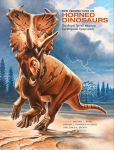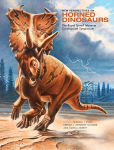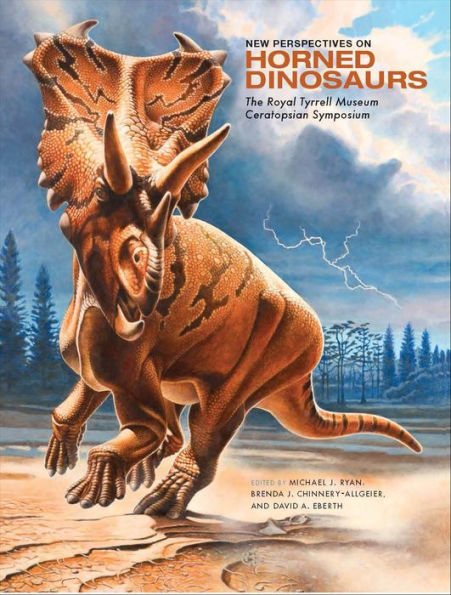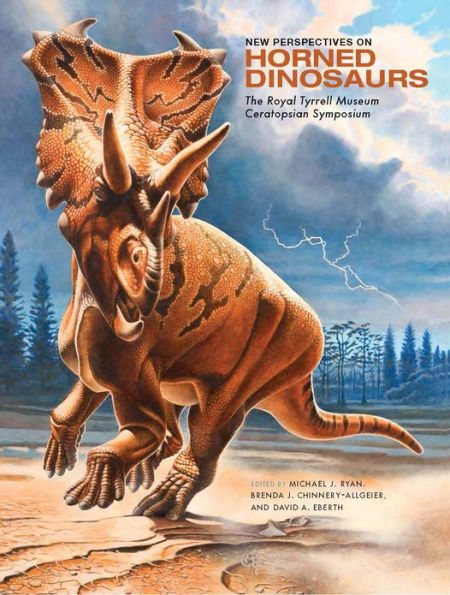Easily distinguished by the horns and frills on their skulls, ceratopsians were one of the most successful of all dinosaurs. This volume presents a broad range of cutting-edge research on the functional biology, behavior, systematics, paleoecology, and paleogeography of the horned dinosaurs, and includes descriptions of newly identified species.
Easily distinguished by the horns and frills on their skulls, ceratopsians were one of the most successful of all dinosaurs. This volume presents a broad range of cutting-edge research on the functional biology, behavior, systematics, paleoecology, and paleogeography of the horned dinosaurs, and includes descriptions of newly identified species.

New Perspectives on Horned Dinosaurs: The Royal Tyrrell Museum Ceratopsian Symposium
1527
New Perspectives on Horned Dinosaurs: The Royal Tyrrell Museum Ceratopsian Symposium
1527eBook
Available on Compatible NOOK devices, the free NOOK App and in My Digital Library.
Related collections and offers
Overview
Easily distinguished by the horns and frills on their skulls, ceratopsians were one of the most successful of all dinosaurs. This volume presents a broad range of cutting-edge research on the functional biology, behavior, systematics, paleoecology, and paleogeography of the horned dinosaurs, and includes descriptions of newly identified species.

Product Details
| ISBN-13: | 9780253007797 |
|---|---|
| Publisher: | Indiana University Press |
| Publication date: | 06/06/2024 |
| Series: | Life of the Past |
| Sold by: | Barnes & Noble |
| Format: | eBook |
| Pages: | 1527 |
| File size: | 36 MB |
| Note: | This product may take a few minutes to download. |
| Age Range: | 18 Years |
About the Author
Michael J. Ryan is Vice-Chair Curator and Head of Vertebrate Paleontology at the Cleveland Museum of Natural History.
Brenda J. Chinnery-Allgeier is Lecturer in the School of Biological Sciences at The University of Texas at Austin.
David A. Eberth is a senior research scientist at the Royal Tyrrell Museum in Drumheller, Alberta, Canada.
Read an Excerpt
New Perspectives On Horned Dinosaurs
The Royal Tyrrell Museum Ceratopsian Symposium
By Michael J. Ryan, Brenda J. Chinnery-Allgeier, David A. Eberth
Indiana University Press
Copyright © 2010 Indiana University PressAll rights reserved.
ISBN: 978-0-253-35358-0
CHAPTER 1
Forty Years of Ceratophilia
PETER DODSON
With the death of my beloved and highly esteemed mentor John Ostrom (1928–2005), I seem to have become the dean, or at least the senior citizen, of ceratopsian studies. Of course my interest in dinosaurs came from my childhood in the 1950s, at a time when there was not nearly so much dinosaur "stuff." A vivid early encounter with dinosaurs came when my mother, a lover of classical music, took me to see Walt Disney's Fantasia. I was enthralled by the paleontology segment that started with the beginning of unicellular life in the primordial seas and ended with the death march of the dinosaurs to the stirring chords of Stravinsky's Sacre du Printemps. Growing up in South Bend, Indiana, we also visited the Field Museum in Chicago, where I remember the mummies but not the dinosaurs. I really liked the coal mine at the Museum of Science and Industry! My father, a professor of evolutionary biology, nourished me with Colbert's (1951) The Dinosaur Book and Roy Chapman Andrews's (1953) All About Dinosaurs. My early experiences were very important to my formation. In consequence I always consider it a privilege when children (of any age) visit my lab or when I am invited into an elementary school to share some of the excitement of my field with them. Who knows which of them will become one of the next generation of paleontologists? I corresponded briefly with a bright fifth-grader from rural New York State years ago, met him as a freshman at his college a decade later, supervised his Ph.D. at the University of Pennsylvania, and now enjoy his collegiality at the Carnegie Museum. Matt Lamanna is certainly living proof for the need to take children seriously!
My family moved to Aylmer, Québec, a suburb of Ottawa, Canada's capital, when I was 11 years old. I lived at home and attended the University of Ottawa, where my father taught, enjoying the benefits of home cooking and free tuition. I date my own entry into the field of paleontology from 1968, the year of my graduation from university and my entry into graduate school at the University of Alberta. Thus my professional activities span parts of five decades and, God willing (shudder!), soon enough to be six decades. Moreover, my personal acquaintances in paleontology range not only to the beginning of the twentieth century in the persons of such luminaries as George Gaylord Simpson (b. 1902); E. H. Colbert (b. 1905); E. C. Olson (b. 1910), but back into the nineteenth century (A. S. Romer, b. 1894). These historical greats still attended Society of Vertebrate Paleontology annual meetings when I began to attend, beginning in 1967. As a ceratophile (I seem to have coined this fairly obvious term, meaning "lover of horns," and applied it in my book to Darren Tanke and myself [Dodson 1996: 180]), I am proudest of all to have known Charles M. Sternberg (1885–1981). He still came into the paleo labs of the National Museum of Canada once a week during the summer that I worked in the prep lab under the supervision of Dale Russell, my ever-ebullient mentor and friend. One of my great regrets is that I never took C. M.'s photograph. My sense of history was deficient in those days—only as I matured did I gain a proper sense of awe at the human dimension of discovery and scholarship. It is difficult to think of oneself as part of history. However, one can at least accept that each of us is part of a continuum. In an academic sense, I did not spring fresh from the brow of Job, but I am the product of my academic mentors, Dale Russell (National Museum of Canada—now the Canadian Museum of Nature), Richard C. Fox (University of Alberta), and John Ostrom (Yale University)—thanks, Dads! Through John Ostrom I can trace my lineage back through E. H. Colbert, to Henry Fairfield Osborn and W. K. Gregory, from the former to E. D. Cope, and then back to Joseph Leidy (1823–1891), who is revered as the father of American paleontology. Note that through my Yale and Philadelphia sojourns, there is an interesting blending of both the Marsh and Cope legacies!
I did not set out to become a student of horned dinosaurs. It just sort of happened. It was a quiet field when I entered it, and remained so for many years, but for the last decade and a half it has been very active. I majored in geology at the University of Ottawa, and although paleontology was part of the curriculum, I enjoyed sedimentology and geomorphology as well, and considered these fields for graduate work. I participated in fieldwork on Somerset Island in the Canadian Arctic in 1965 and 1966. Here I collected Silurian shelly invertebrates and Devonian ostracoderms and placoderms with David Dineley, as my introduction to field paleontology. In 1967, I spent a magical summer before my senior year in the ancient paleo laboratory at the National Museum of Canada. It was in this limestone block building at Sussex and Georgestreets where Lawrence Lambe began to put Canadian dinosaurs on the map in the early 1900s. Here I met C. M. Sternberg, a hoary link to a glorious past. He was old and stooped, but his eyes still sparkled. I also met Wann Langston, Jr., who spent a month there in his study of Pachyrhinosaurus canadensis. There Dale Russell became my mentor and friend. That summer Gilles Danis and Gerry FitzGerald began their careers in paleontology as well. This auspicious alignment of the planets, so to speak, confirmed my desire to become a paleontologist. Initially I planned to go to Austin and do a master's degree with Wann Langston at the University of Texas, but in 1968, the Vietnam War was raging, and it seemed to make a great deal of sense to remain in Canada for a while. Dale Russell encouraged me to apply to the University of Alberta to study with Richard C. Fox, which I did. Dale provided me with ideas both for my master's research and my Ph.D. I spent the summer of 1968, 10 weeks of it, living in a tent at Dinosaur Provincial Park, Alberta, with my new bride and field assistant, Dawn. Here I walked over the decaying remains of ceratopsians while collecting taphonomic data for my master's thesis (Dodson 1971), but did not otherwise latch onto ceratopsians as the objects of my desire.
My first research encounter with ceratopsians arose when I went to Yale for my Ph.D. in 1970. It may be said that in those days dinosaur studies were in a "quiet" phase in the United States. Colbert had retired from the American Museum of Natural History and had moved to Flagstaff. It was only at Yale that dinosaur studies were being pursued with vigor by young John Ostrom, whose studies on hadrosaurs (Ostrom 1961, 1964a) and ceratopsians (1964b, 1966) certainly attracted my attention. John had just completed five years of fieldwork in the Early Cretaceous Cloverly Formation of the Bighorn Basin, and in announcing the exciting discovery of the hot-blooded predator Deinonychus (Ostrom 1969) introduced an entire new dinosaur fauna including the basal iguanodontian, Tenontosaurus, the nodosaurid Sauropelta, and the problematic small theropod Microvenator (Ostrom 1970a). My arrival at Yale coincided with Ostrom's rediscovery of a specimen of Archaeopteryx, the first new one to be recognized since 1877 (Ostrom 1970b). Unknown to me until my arrival in New Haven was a certain long-haired, bearded, and chromatically attired gentleman named Robert Bakker, who filled the air with colorful descriptions of warm-blooded dinosaurs. Bob was a stimulating friend and an important intellectual influence on me. These were exciting times at Yale. Jim Farlow arrived at Yale two years later, and he looms large in my early ceratopsian studies.
My work at Yale involved biometric studies of growth series of dinosaurs (Dodson 1974). Ostrom wisely counseled me to begin my work with alligators, to establish my knowledge of basic reptilian osteology, to hone my practical techniques of measurement with the tools of the trade, calipers and tape measure, and to get a handle on analytical techniques. Alligators are to paleontologists what Drosophila is to geneticists or Caenorhabditis elegans is to developmental biologists. I hesitate to admit just how primitive my analytical techniques were. I resisted acquiring competence with computers long past the point of reasonableness. This was, of course, long before the advent of desktop computing. The personal computer had not been developed (I acquired my first personal computer only in 1984, and it was unspeakably crude by today's standards—word processing programs did not yet have spell checkers!).
The alligator study (Dodson 1975a) proved to be a very useful baseline, and it continues to be cited in a variety of contexts by paleontologists whom I admire, even in recent years (e.g., Houck et al. 1990; Clark et al. 2000; Brochu 2001; Erickson et al. 2003; Chinnery 2004; Farlow et al. 2005; Evans et al. 2005). I also published a study of two closely related species of Sceloporus lizards, based on a data set kindly provided by Ernest Lundelius (Dodson 1975b). This study provided a careful analysis of a data set that was complicated by both sex and taxonomy. The sexual difference was real but proved difficult to uncover. At last I was ready to take on dinosaurs in twoconceptually related studies. The easier case was that of Protoceratops, the more difficult case that of Canadian lambeosaurine hadrosaurs.
Protoceratops andrewsi is one of the great treasures of the American Museum of Natural History's famed Central Asiatic Expedition of the 1920s, headed by the flamboyant Roy Chapman Andrews. Using the magnificent display skulls, I was ready to tackle growth in size from small specimens (basal length 76 mm) to large (basal length 357 mm). Using both bivariate plots and multivariate statistics (Fig. 1.1), I showed that there is a distinct dimorphism in the large specimens. One group of specimens showed an arch over the nose (site of the presumptive nose horn), broadly flaring jugals, and a broad and elevated frill. The second group consisted of specimens with less arching over the nose and with frills that were slightly lower and narrower (Fig. 1.2). The smaller specimens plotted with the latter group of large specimens. The dimorphism demands explanation, and no one has ever argued for two species for the specimens from Shabarak Usu (Lambert et al. 2001 recently named P. hellenikorhinus from Inner Mongolia). Accordingly, my interpretation is that the dimorphism is sexual in nature, and that males had the taller, wider, showier skulls. The crest of Protoceratops is eggshell thin, and fits well, in my judgment, the paradigm of a display structure rather than a mechanical framework for jaw muscles. Sexual dimorphism had been suggested before for Protoceratops, tentatively by Brown and Schlaikjer (1940), analytically by Kurzanov (1972), who had only seven skulls to work with; but my study (Dodson 1976) was the most rigorous mathematically and had the largest sample size and growth range. The specimens in my study also all came from the same Mongolian locality, the Flaming Cliffs of Bayn Zag.
Claims of sexual dimorphism in dinosaurs are properly greeted with skepticism (e.g., Sampson and Ryan 1997; Padian et al. 2005). In order to sustain a strong claim for sexual dimorphism, a significant sample of specimens is required from the same locality (thus ruling out geographic or chronological complications), ideally spanning a significant size range so that ontogenetic variation can be accounted for. Rigorous morphometric analysis is also required. These exacting requirements have rarely been met in dinosaur studies. The case for sexual dimorphism in Protoceratops is arguably the best in all of dinosaur paleontology. My attempt to infer sexes in lambeosaurine hadrosaurs (Dodson 1975c) held up for 30 years, but fell apart two years ago, not because of a faulty morphometric analysis but because new stratigraphic evidence from the Dinosaur Park Formation carefully analyzed by David Evans and colleagues (2006) showed that my putative sexes of Corythosaurus are likely time-successive species. I was wrong (Dodson 2007)!
(Continues...)
Excerpted from New Perspectives On Horned Dinosaurs by Michael J. Ryan, Brenda J. Chinnery-Allgeier, David A. Eberth. Copyright © 2010 Indiana University Press. Excerpted by permission of Indiana University Press.
All rights reserved. No part of this excerpt may be reproduced or reprinted without permission in writing from the publisher.
Excerpts are provided by Dial-A-Book Inc. solely for the personal use of visitors to this web site.
Table of Contents
Preface
Part 1. Overview
1. Forty Years of Ceratophilia
Part 2. Systematics and New Ceratopsians
2. Taxonomy, Cranial Morphology, and Relationships of Parrot-Beaked Dinosaurs
3. A New Species of Archaeoceratops from the Early Cretaceous of the Mazongshan Area, Northwestern China
4. A Redescription of the Montanoceratops cerorhynchus Holotype with a Review of Referred Material
5. First Basal Neoceratopsian from the Oldman Formation, Southern Alberta
6. Zuniceratops christopheri: The North American Ceratopsid Sister Taxon Reconstructed on the Basis of New Data
7. Horned Dinosaurs from the Upper Cretaceous Cerro del Pueblo Formation, Coahuila, Mexico
8. New Basal Centrosaurine Ceratopsian Skulls from the Wahweap Formation, Grand Staircase–Escalante National Monument, Southern Utah
9. A New Pachyrhinosaurus-Like Ceratopsid from the Upper Dinosaur Park Formation of Southern Alberta, Canada
10. New Material of "Styracosaurus" ovatus from the Two Medicine Formation of Montana
11. A New Chasmosaurine from the Upper Cretaceous Ojo Alamo Formation, San Juan Basin, New Mexico
12. A New Chasmosaurine Ceratopsid from the Judith River Formation, Montana
13. Description of a Complete and Fully Articulated Chasmosaurine Postcranium Previously Assigned to Anchiceratops
14. A New, Small Ceratopsian Dinosaur from the Latest Cretaceous Hell Creek Formation, Northwest South Dakota, United States: A Preliminary Description
Part 3. Anatomy, Functional Biology, and Behavior
15. Comments on the Basicranium and Palate of Basal Ceratopsians
16. Mandibular Anatomy in Basal Ceratopsia
17. Histological Evaluation of Ontogenetic Bone Surface Texture Changes in the Frill of Centrosaurus apertus
18. Modeling Structural Properties of the Frill of Triceratops
19. New Evidence Regarding the Structure and Function of the Horns in Triceratops
20. Evolutionary Interactions between Horn and Frill Morphology in Chasmosaurine Ceratopsians
21. Skull Shapes as Indicators of Niche Partitioning by Sympatric Chasmosaurine and Centrosaurine Dinosaurs
22. The Function of Large Eyes in Protoceratops: A Nocturnal Ceratopsian?
23. A Semi-Aquatic Life Habit for Psittacosaurus
24. Habitual Locomotor Behavior Inferred from Manual Pathology in Two Late Cretaceous Chasmosaurine Ceratopsid Dinosaurs, Chasmosaurus irvinensis and Chasmosaurus belli
25. Paleopathologies in Albertan Ceratopsids and Their Behavioral Significance
Part 4. Horned Dinosaurs in Time and Space: Paleobiology, Taphonomy, and Paleoecology
26. An Update on the Paleobiogeography of Ceratopsian Dinosaurs
27. Unraveling a Radiation: A Review of the Diversity, Stratigraphic Distribution, Biogeography, and Evolution of Horned Dinosaurs
28. A Review of Ceratopsian Paleoenvironmental Associations and Taphonomy
29. Behavioral Interpretations from Ceratopsid Bonebeds
30. Paleontology and Paleoenvironmental Interpretation of the Kikak-Tegoseak Quarry, Northern Alaska: A Multi-Disciplinary Study of a High-Latitude Ceratopsian Dinosaur Bonebed
31. Taphonomy of Horned Dinosaurs from the Late Campanian Kaiparowits Formation, Grand Staircase–Escalante National Monument, Utah
32. A Centrosaurine Mega-Bonebed from the Upper Cretaceous of Southern Alberta: Implications for Behavior and Death Events
33. Insect Trace Fossils Associated with Protoceratops Carcasses in the Djadokhta Formation, Mongolia
34. Faunal Composition and Significance of High-Diversity, Mixed Bonebeds Containing Agujaceratops mariscalensis and Other Dinosaurs, Aguja Formation Big Bend, Texas
Part 5. History of Horned Dinosaur Collection
35. Lost in Plain Sight: Rediscovery of William E. Cutler's Missing Eoceratops
36. Historical Collecting Bias and the Fossil Record of Triceratops in Montana
Afterword
Index
Supplemental CD-ROM
1. A Ceratopsian Compendium
2. Ceratopsian Discoveries and Work in Alberta, Canada: History and Census



